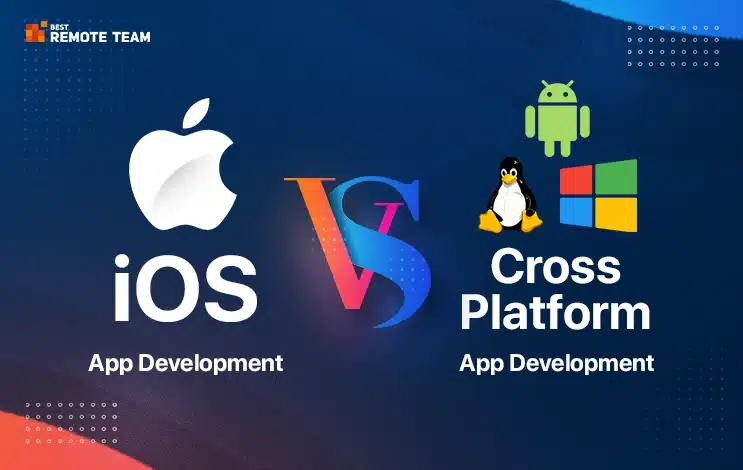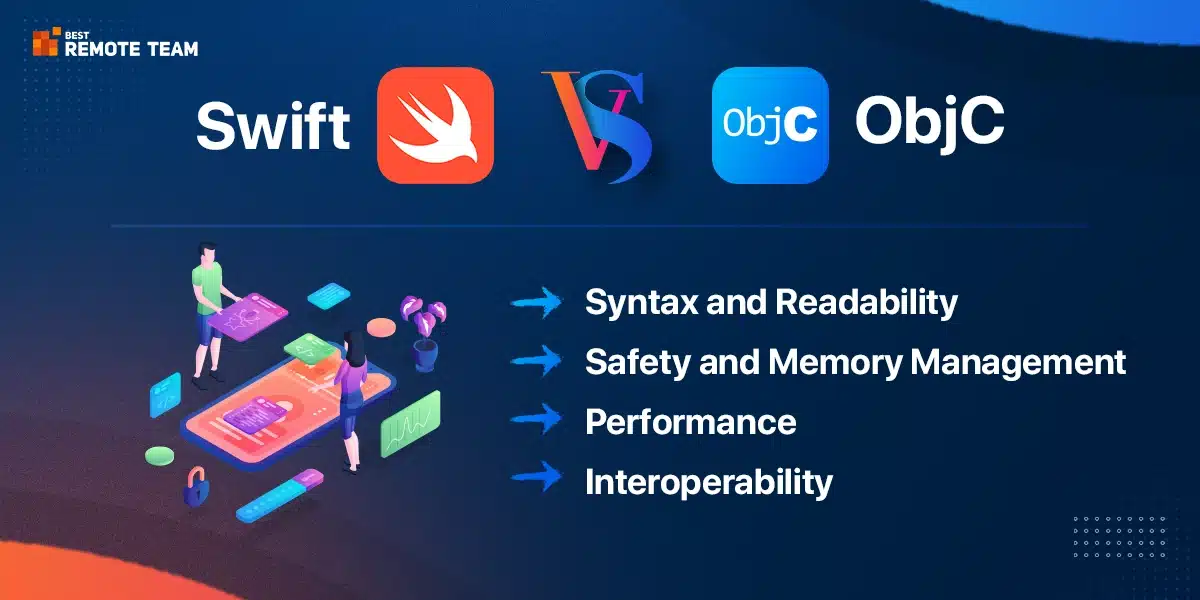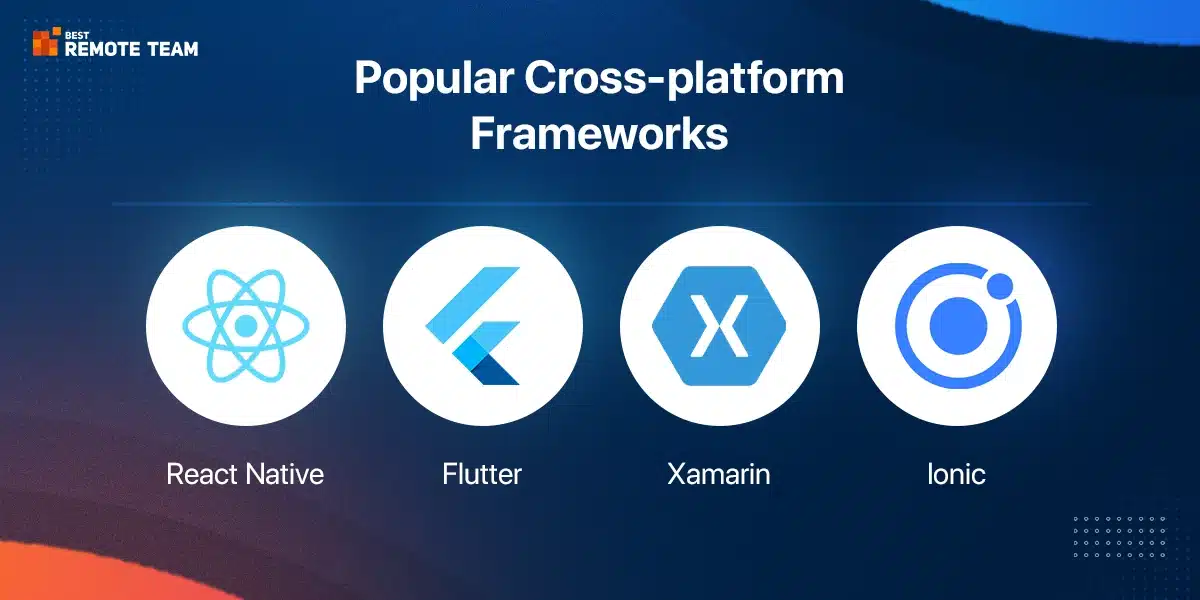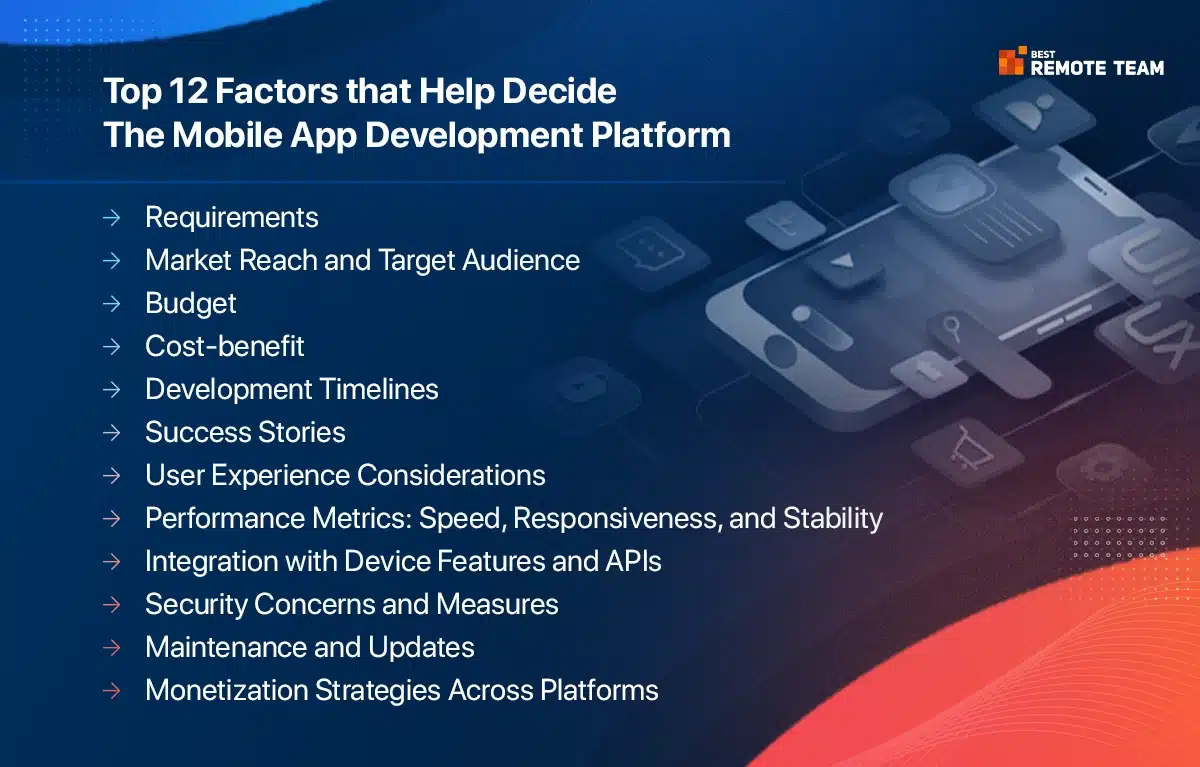Going In-depth with iOS App Development
Imagine your app as a custom-built Ferrari. Sleek, powerful, and designed to purr on Apple’s roads like a dream.
Native apps are appealing as they can easily access the iOS ecosystem. You can easily leverage the performance and features that are unique to the platform. Moreover, you can also integrate with third-party tools unique to Apple products with ease.
It is easier to extend your applications and their capabilities with iOS app development. The continuous expansion of the user base combined with an increasing number of apps has led to the platform’s exponential growth.
Diverse apps have been developed for the iOS platform ranging from productivity tools to gaming solutions. According to the data from Business of Apps, there are approximately 1.7 million apps on the Apple store. The total downloads in 2023 Q1 were slated at 8.1 billion.
These numbers indicate the popularity of the platform and its capabilities. When you are talking about iOS, you must engage in a conversation about the programming languages. Swift and Objective-C offer great abilities and enhance the code quality.
Let’s quickly compare the two to understand the platform better.
1) Swift vs Objective C
As part of this article, we will compare the two languages against multiple factors.
1) Syntax and Readability
Swift extends an expressive syntax that helps build readable code. You can use type inference to make the code clear and reduce boilerplate codes. However, you may need to frequently update the code to incorporate new features and syntax.
Objective-C uses the traditional syntax that C and C++ users are familiar with. It is a stable syntax, which means it doesn’t update too often. However, it is a verbose syntax, which can increase the code length.
2) Safety and Memory Management
You can build a safe code with type safety, optional, and automatic memory management features. This will enhance the code quality and reduce the bugs. The learning curve for this syntax is steep.
Objective-C uses a manual memory management method for optimization. In some cases, the developers have greater control over the memory management and deallocation abilities. However, this can cause leaks and bugs that induce code crashes.
3) Performance
Swift is comparatively faster and includes modern optimization methods. The code could possess overhead due to options or dynamic dispatch.
Objective-C offers extensive performance owing to C and C++ components. However, the programming language doesn’t support modern syntax. This can impact the overall performance.
4) Interoperability
Swift can seamlessly integrate and interoperate with Objective-C. As a result, you can gradually convert Objective-C projects using Swift. Objective-C interoperates with C and C++ libraries. It can incorporate the Swift code but incrementally.
2) Advantages of iOS
iOS offers extensive benefits to app developers. Apart from the ecosystem and community support, it also extends other exceptional benefits.
- It can easily integrate with the Apple ecosystem, thus extending a consistent and valuable experience.
- As the iOS apps are optimized for the Apple hardware, you will notice seamless performance and responsive app solutions.
- Your apps will be added to the Apple store, thus offering greater visibility to your business.
- Apple apps are known for extending maximum security and safe data transactions. This can be attributed to the stringent review processes at the store.
- Your developers can access the latest technologies or features before others, thus fostering app innovation.
- There are several developer-friendly tools that simplify app development.
- You can adhere to the designated design guidelines to produce consistent and appealing applications.
3) XCode and Development Tools
iOS offers an ecosystem that makes developing apps effortless. You can rely on the integrated tools and third-party services to build robust and high-performing applications.
1) XCode for Developers
- This is the ideal Integrated Development Environment that can help streamline all development tasks.
- You can easily use Swift or Objective-C to build your apps. Owing to a simplified UI builder, you can easily create the client-side for the application.
- It also extends the debugging tools like LLDB and XCTest to improve code stability and app responsiveness.
2) For Performance and Collaboration
- You can use the profiling tools to improve memory utilization and energy consumption.
- It can also help handle memory issues and remove bottlenecks.
- It also provides integration with Git to ensure streamlined version control.
- You can also enhance collaboration with these tools to track changes and manage the code history.
3) Documentation and Deployment
- Your developer’s environment integrates with the app store connect for simplified app submissions.
- It also enhances code signing and helps deploy efficient workflows.
- As your developer can easily integrate with WWDC sessions, they are abreast with the latest developments.
4) Cost-Benefit Analysis
When analyzing the approaches, you must conduct a detailed cost-benefit analysis.
1) The Cost Analysis
The costs are divided into two segments- development of the solution and maintaining the app.
#1) Development Costs
There are several aspects under this heading. Let’s explore each element to understand how you can calculate the cost of developing an iOS application.
- Hiring Costs: You must hire competent and skilled iOS developers with the experience and expertise for the application. This means offering salaries or payments that are competitive. Location, experience, and several factors impact this cost.
- Infrastructure: You must invest in the tools and licenses that enable you to develop effortlessly. For instance, you must join the Apple developer program. These costs must be added to your overhead.
- Testing Devices: You cannot release the app unless you have tested it on different iOS devices. It is crucial to acquire these devices. This can become an additional expense.
#2) Maintenance Costs
- Frequent Updates: You must continuously improve the application. This requires adding new features and incorporating user feedback. You must have the infrastructure and resources to handle these updates.
- Bug Fixes: You need a developer who can continuously improve the app by patching the bugs. They should constantly work on enhancing the app’s quality.
- You must ensure the apps are aligned with the new OS versions. This is an ongoing expense for your team.
2) The Benefits Analysis
Your benefits are segmented into three parts- user experience, app store exposure, and brand loyalty.
#1) User Experience
Experience is a result of good performance, quality application, and exceptional design.
- Your app can leverage the native elements and components. As a result, they exhibit high performance and responsiveness.
- When you are building iOS apps, you adhere to the platform-specific design guidelines. This can improve the app’s familiarity and consistency. As a result, app users enjoy using the application.
#2) App Store Exposure
- You are part of the exclusive Apple store. As a result, your apps gain higher visibility. This can improve the app’s discoverability, resulting in excellent downloads.
- Owing to the excellent user base, you have many monetization opportunities. You can include in-app purchases as a possibility.
#3) Brand Loyalty
- You enjoy a premium user base, which results in increased engagement. They may look forward to the updates and use the app often.
- It is easier to integrate with other Apple apps and tools to extend the app’s capability.
5) Smooth Integration with Apple’s Ecosystem
When choosing Apple, you are also choosing a seamless integration with its ecosystem.
- You can get a cohesive experience across the different Apple devices such as iPhones, iPads, Macs, and Apple Watch.
- You can use features like continuity and handoff that help enable smooth transitions. As a result, users can continue their activity using Apple devices.
- Data is automatically synced to the iCloud. This increases data accessibility, translating into an excellent user experience.
- You will need an Apple ID and a single Sign-on to download and access the data. This enhances the security.
6) Potential Drawbacks of iOS
Like every other framework or approach, iOS offers several limitations.
- You must pay an annual fee to access the Apple developer program. This can limit iOS access for small or independent developers.
- The app store policies are strict. As a result, you must be prepared for long approval times. If you don’t want it to impact your launch time, you must be ready with your app in advance.
- The ecosystem is closed. As a result, non-iOS devices cannot enter into this segment
- The customization is restricted by the design and interface restrictions. As a result, you may not be able to customize much with Apple’s operating system.
App Development Cost Showdown: iOS vs. Cross-Platform
| Region | Developer Hourly Rate ($ USD) | Simple App Cost (3-6 months) | Complex App Cost (12+ months) |
| iOS App | |||
| United States | 50-150 | 18,000-54,000 | 36,000-108,000 |
| United Kingdom | 40-100 | 12,000-36,000 | 24,000-72,000 |
| India | 30-70 | 7,200-21,600 | 14,400-43,200 |
| Ukraine | 25-50 | 6,000-15,000 | 12,000-30,000 |
| Cross-Platform App | |||
| United States | 30-80 | 10,800-28,800 | 21,600-57,600 |
| United Kingdom | 25-60 | 9,000-21,600 | 18,000-43,200 |
| India | 20-40 | 6,000-12,000 | 12,000-24,000 |
| Ukraine | 15-30 | 4,500-9,000 | 9,000-18,000 |
Cross-platform App Development- In-depth Understanding
Think of this approach as a multi-terrain SUV. It might not be as flashy as the Ferrari, but it can handle all kinds of roads (Android, Windows, etc.) with ease.
Cross-platform app development is gaining strong support from the developers. As it is a versatile method, it allows developers to create and deploy the application across multiple platforms.
You can use platforms like React Native or Flutter to accelerate development and improve code sharing. Each platform expresses unique ability and has the backing of a strong team of developers.
You need to develop a single codebase that can be shared across platforms; as a result, it enjoys a thriving market. According to GlobalNewsWire, the cross-platform market size is expected to reach $546.7 billion. This can be attributed to the increasing mobile adoption and a shift towards more inclusive development.
Let’s explore this approach in detail.
1) Some Popular Cross-platform Frameworks
This approach enjoys several frameworks that have made it easier for the developers. Let’s look at each of these popular platforms.
#1) React Native
This JavaScript framework is backed by Facebook. It offers efficient app development, fostering reusability and shared codebases. You can deliver native-like experiences using this approach.
#2) Flutter
This framework is slowly becoming the app developer’s favorite. It is based on the Dart programming language, which makes up for visually attractive interfaces. This framework allows you to share the logic, codebase, and interface design.
#3) Xamarin
Backed by Microsoft, this framework is developed using C# and .Net. You can share the code to build your applications. It is a great framework that enhances app efficiency. Additionally, it enables optimization.
#4) Ionic
This is a great framework for building hybrid applications. It works with the latest and traditional web technologies. It carries a single codebase that is shared across platforms and browsers.
2) Advantages of cross-platform
Let’s take a look at why people prefer this approach over others.
- As it allows you to reuse the code, you accelerate time-to-market while reducing expenses. This enhances cost efficiency.
- You save a lot of time and make developers productive as they need to develop a single codebase. This allows them to focus on innovative solutions.
- As you are targeting both iOS and Android customers, you can maximize your reach and conversions.
- It is easier to maintain cross-platform apps as they offer a single logic and codebase. This saves a lot of time and effort that goes into maintaining applications.
- The development cycles are faster and shorter. This helps launch new features, improve your validation speed, and enhance the app faster.
- It is easier to scale the cross-platform applications as you are dealing with a single codebase.
3) The Cost-Benefit Analysis
Before you choose an approach, you must conduct a detailed cost-benefit analysis of the approach.
1) The Cost Analysis
Let’s understand the development and maintenance costs that come with this approach.
#1) Development Costs
- You must hire dedicated developers who are proficient with the cross-platform frameworks. As a result, you can reduce the hiring costs. You no longer need platform-specific resources.
- As you have several open-source options in this case, you can minimize the licensing fee. You can also reduce the development cost as the infrastructure may be available for free. However, in some cases, where you need advanced features, you might need to pay a platform fee.
- You don’t need to test across devices. there are specific tools that automate the testing process, thus reducing time and resource requirements.
#2) Maintenance Costs
- You can simultaneously update the app across multiple platforms. This allows you to be more productive and enhance consistency. You might need to make small tweaks to incorporate platform-specific changes.
- You can minimize the compatibility issues, and offer extensive improvements. As a result, you can easily incorporate the changes.
- It is easier to fix bugs in a single codebase and apply it across the platforms. This saves a lot of money and resources.
2) The Benefits Analysis
This is divided into cost, time-to-market, and reach benefits for the businesses.
#1) Reduced Overhead
- You can use a single codebase and deploy it across platforms. This reduces the development time.
- Additionally, you don’t need to invest the resources to build two different apps. A single team can help build the application.
#2) Time-to-Market
- You need to write the codebase once and share it everywhere. This reduces the development cycle and accelerates launches.
- You can also update the application simultaneously, thus ensuring quick changes and releases.
#3) Wider Reach
- When you develop for Android and iOS platforms, you enjoy a broad audience base. This results in a solid user base for your business.
4) Potential Drawbacks
There are always limitations to every approach you take. Here are a few limitations of using cross-platform app development.
- You may not be able to leverage the platform-specific features in all cases. This can limit the functionality you add to the application.
- If you build a graphic-intensive or resource-inclusive application, you might face performance issues. It may not be on par with the native applications.
- In the case of new frameworks, you will face a steep learning curve.
- You will be dependent on third-party plugins to extend the app’s functionality. This induces dependencies that can pose challenges later.
Cost-Benefit Analysis: Navigating the Decision-Making Landscape
| Factor | iOS Development | Cross-platform Development |
| Development Costs |
|
|
| Maintenance Costs |
|
|
| User Experience | Tailored user experience and consistency across devices | Lacks a native-like feel despite consistency. Offers design flexibility. Limited integration with the Apple ecosystem |
| App Store Exposure | Exclusive Apple store exposure and high visibility on the marketplace. | You may not enjoy exclusive Apple store exposure |
| Development Time | You need to induce platform-specific nuances to complete the development. Takes time to launch the application | Faster time-to-market using a unified codebase. Simultaneous deployment across platforms |
| Reach | Limited to the iOS user base | Extends across iOS, Android, and other platforms |
| Risk and Adaptability | You don’t face a risk of framework abandonment. This is because iOS is a stable platform. The platform may not be able to adapt to new technologies easily. | Risk of framework discontinuation.
Frameworks can easily adapt to newer technologies. |
Choosing Between iOS and Cross-platform – The Factors
| Factor | iOS Development | Cross-platform Development |
| Project Goals | If you want to target an iOS customer base, you must leverage the platform-specific features. This will help tailor your user experience. | If your goal is to reach the market faster and widen your user base, you must choose cross-platform development |
| Budget | Check if you have a budget that accommodates for platform-specific development and maintenance | If you are low on your budget, you may go with cross-platform development. It will help launch apps for iOS and Android platforms without spending a lot of money. |
| Features | If you have feature specifications that require integration with platform-specific components, you must choose iOs development | If your features are consistent through the platforms, you can go with cross-platform app development. |
| App Complexity | If you want to build complex applications that are complete with high-performance needs, you should use a native approach. It helps improve the workflows and fine-tune the app performance. | If you want to build simple to moderately complex apps with an aim to launch faster, you should choose a cross-platform development approach. |
| Security Needs | App security is best when you choose the iOS development approach. It ensures stringent measures to build the application. | You can bolster the security. However, you must choose the frameworks and tools that have inherent security features. |
| Long-term Development Plans | Go with platform-specific development if you plan on building a long-term application. | If you are opting for scalability and expansion, go with cross-platform development. |
When to Choose iOS vs Cross-Platform Development Approach?
It is important to note when you can go with iOS app development versus a cross-platform solution.
iOS App Development: When to Choose?
- When you want to target an affluent customer base that uses Apple devices, you must use this approach.
- If you want to extend an immersive and interactive user experience, go with iOS development.
- When you want to develop newer and excellent revenue streams to attract conversions and returns.
- If you want to offer exclusive features or app releases to the market, you can adhere to a dedicated timeline.
- If you want to build security-first applications for the business.
Cross–platform Development: When to Choose?
- If you want to widen your reach and enter diverse markets to improve your brand’s visibility.
- If you have limited resources and budget, this method is best for your needs.
- It can help you accelerate time-to-market. when validating the idea or building prototypes, you can use this approach.
- If you want to simplify maintenance and updates for the application, choose this approach.
- It is best for startups and emerging companies as they have limited budgets.
Success Stories: iOS vs Cross-Platform Development Approach
Explore the world of success as defined by iOS and Cross-platform development.
iOS App Development
- Instagram: It is a photo-sharing app that leverages integration with iOS devices to extend its functionality. It can easily use platform-specific features to boost the experience.
- Calm: This meditation app follows the design guidelines expressed by iOS. As a result, you access a visually aesthetic and functional application.
- Headspace: Mindfulness application that leverages iOS features to deliver a user-friendly design. it is in sync with the Apple user’s mindset and behavior.
Cross-Platform App Development
- Facebook Ads Manager: This platform was developed to help marketers create and manage ad campaigns. The React Native platform used to build this solution allows a seamless experience on iOS and Android platforms.
- WhatsApp: This was built using React Native and extends native-like functionality. Moreover, the experience is consistent across the two platforms.
- Alibaba: The online shopping app used Flutter to build its solution. The Dart programming language, unified codebase, and interface design ensure consistency and seamlessness.
Factors that Help Decide the Mobile App Development Platform
Choosing the mobile app development platform should be your foremost consideration when planning the application. Here are all the factors that can help you select the right solution.
1) Requirements
When choosing the platform, consider the functionalities, interaction needs, and design choices. This will help you realize if you want to go with native or cross-platform approaches.
2) Market Reach and Target Audience
Whether you want a specific audience base using the app or to widen your reach will help you make the platform choice faster. If you want to diversify your user base, you must choose cross-platform.
3) Budget
If you are operating on a limited budget, you can go with cross-platform. It can help you validate the application and launch your business to the market. If you have an extensive budget and can think beyond cross-platform, you can go with iOS.
4) Cost-benefit
Compare the costs and the potential benefits for platform-specific and cross-platform app development. This will help you realize which is beneficial for your business. It is important to ensure that the cost-benefit is equivalent.
5) Development Timelines
This is an important factor when choosing the approach. You may be looking at developing prototypes and getting the user’s validation. This requires a quick release and a shorter development cycle.
If you are looking at a long-term solution, you might invest in a longer development cycle. The platform choices and development approaches will differ in each case.
6) Success Stories
Research is key to making the right choice. You might want to study the several success stories in the niche before proceeding with making your own. You can make the choice based on the most successful approach for your idea.
7) User Experience Considerations
Users love a usable, accessible, and structured application. If your app offers a consistent and tailored experience, they may enjoy using it. You must choose an approach that extends consistency and personalization.
8) Performance Metrics: Speed, Responsiveness, and Stability
You must specify the performance requirements for your application. If you are building apps with graphics and a lot of elements, you must ensure it extends seamless performance. Similarly, you may need a less intensive approach for apps that demand reduced resources.
9) Integration with Device Features and APIs
Check if the approach allows you to seamlessly integrate with the different devices and APIs. It is an important consideration if you want to extend the app’s capability. Make sure they offer consistent and standardized access to the device features as well.
10) Security Concerns and Measures
Security is an important consideration when making the platform choice. You need a more closed and secure environment when building finance or retail applications. Your platform choice will depend on the security requirements and the platform’s abilities.
11) Maintenance and Updates
When choosing a platform, you must look at the long-term abilities as well. You must be able to maintain the application on the platforms seamlessly. Moreover, it should be easier to debug and improve the application.
12) Monetization Strategies Across Platforms
Every application should translate into good ROI for the business. you must choose an approach that offers the best monetization abilities. It will help you build a strong revenue stream and enjoy conversions.
Future Trends and Technological Shifts
It is equally important to look at the future while making the choice for your current app development project.
1) Anticipating the iOS Evolution
iOS will continue to evolve to rule the mobile app development world. Apple will continue to release new features and update the operating system to suit newer needs and shifting development practices.
With tech advancements, iOS must integrate these technologies to foster innovation. You will notice a surge in these advancements that can help extend app features and functionality. Moreover, integration with SwiftUI will help create a more dynamic user experience.
Apple will continue its efforts to boost security and privacy for better app development practices.
Here are Some iOS App Development Trends:
- SwiftUI
- focuses on Performance and Optimization
- Augmented Reality (AR) and Virtual Reality (VR)
- Machine Learning, and Artificial Intelligence
2) Adapting to Cross-platform Innovations
The frameworks will continuously improve and adapt to new requirements. The framework community is focused on boosting the performance and seamless capabilities of the platform. They are also ensuring support for newer technologies.
The developers may notice more standardized methods and solutions in this realm. Moreover, the cross-platform approach will adopt the PWA concepts that can unify web and mobile development. This will shorten the cycles and accelerate the releases.
Here are Some Cross-platform App Development Trends:
- Cross-Platform Frameworks
- Improved Performance and Native-like Feel
- Focus on Developer Experience
- Wider Platform Reach
Conclusion
As you embark on your mobile app development journey, it is crucial to make informed choices. You must compare the two approaches- cross-platform development and iOS before completing the choice.
Define your requirements, target market, and long-term goals to complete the choice. You can also consider the optimization and exclusivity requirements when completing the decision. The final decision relies upon the cost-benefit analysis for each approach.
Best Remote Team understands the need for an expert iPhone app development company to support your vision. We offer a fully vetted and highly experienced team of iOS developers to help meet your project goals and app requirements.
You can connect with our experts to hire an iOS app developer and further your app idea.







